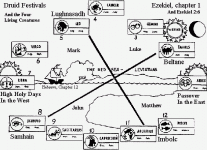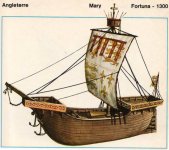New Gold
Full Member
1)The Freemasons could have used a small work force to start and prepare the preliminary work for the “Oak Island’s Tunnels and Shaft” with knowledge and instructions supplied from past “Enlightened Patrons”.
The preliminary work? How long do you think it would take a "company of cornish miners" to hand-dig the money pit, let alone the flood tunnels? This was no week long affair. Coffer dams had to be built, box drains had to be built, this was a major undertaking! Even moving some of those boulders around would have been a daunting task!
Work may have been done during the day under the guise of scraping the hull of a ship.
How long does it take to scrape the hull of a ship vs build a network of tunnels a hundred feet below the ground?
The original discovers had reported locating a large bolder in “Smith’s Cove” with a “hand forged iron ring-bolt” inserted in it.
This could have been placed by any group of sailors happening to pass by the area looking to moor for the night.
This “ring” was only visible at low tide and may have been used by seafarers to moor and careening "heaving down" their boats.
It would have made a good and accepted moorage for sea boats, due to its proximity to the mainland and the large tide variance in Mahone Bay.
See above. Anyone could have placed the ring, it was a high traffic area for sailors.
I would “Imagine” that when the main “Flotilla of Ships” arrived, they would have moored farther out to sea, with some of the workforce camped on “Frog Island” and only those day workers doing impending work located on “Oak Island”.
A flotilla of ships surely would have caught the eye of the locals? It would have been near enough to clearly see. "Hey Bob, I wonder what those ten huge ships are doing moored out by Oak Island?"
The positioning of these islands (especially Frog Island) to the Mainland offered a reduced exposure to locals seeing any lights, unless someone at night had gone out to sea or avoided and bypassed the posted Sentries on these Islands.
Frog island is still visible from the mainland. Camp fires burning on Frog island would be quite visible from the mainland. Any activity on either Frog or Oak islands for the amount of time this construction would have taken would have been noticed and surely remarked upon. If they wanted to work in secret, which they obviously would have, they could have picked a better island! Maybe one not so close to the mainland?
During the 18th Century and without electricity, locals tended not to go out or stray far from their lodgings at night.
Lights seen at night were usually attributed to some sort of encampment or worse, part of evil folk lore.
So you admit that lights seen at night would have been noticed by the locals. Nowadays no one would even bat an eyelid. Back then a camp fire on an uninhabited island would have stuck out like a sore thumb.
There was only one need for the “Freemasons” to work at night on “Oak Island” and that was to set their markers or relocate these markers if they had been tampered with.
How exactly did they move those big granite boulders around? At night? Without making a hell of a ruckus?
The Celestial Settings of these markers would have been done at “Midnight during the Autumn Equinox” and the use of lanterns would have been necessary.
The Original Discoverers stated sightings to have occurred when the lights from the “American Navy” and “American Freemason Workers” were seen with their recovery mission.
This is a giant Robot "assumption." For all we know the lights were from other kids wandering around at night. After months of camping and working on the islands, the presence of these workers would surely have been known to the locals. So why would the discoverers be surprised by a few lights in the darkness? Why didn't they find the true location of the vault buried just twenty feet below ground? Surely the dirt would have been fresh if the brits had just dug up their treasure?
These American Ships were safely venturing into British waters protected under the “Treaty of Amity 1794” with the full approval of President George Washington and the Freemasons controlling the Royal Navy out of Halifax.
Their brief stop at “Oak Island” was to “Open” the “Treasure Vault” and “Remove” the “Freemason’s Treasures”.
Surely it would take more than one night to dig up the vault and remove boatloads of treasure right? Why didn't the boys see anything during the day?
The “Entry” to the “Treasure Vault” was “Concealed” and its “Contents” were “Whisked” away to their “New Protected Home”.
What home could be more protected than this? A vault system deep below ground with flood tunnels connected to the ocean? On an uninhabited island? Ain't no flood tunnels in Washington. Or New Ross for that matter.
View attachment 1084876
2)
How 14th Century Fiber and 18th Century Items could be Compatible
Yes, the argument of the Coconut Fiber carbon dating has been a stumbling block with my theory.
All the wood samples carbon dated support my theory's 18th Century time period.
Wood, especially hardwood, is notoriously hard to carbon date. This is known as the old wood effect. The heartwood of hardwood species is usually centuries old by the time the tree is felled. If the wood is taken from different parts of the tree it will date differently. Not to mention the fact that eighteenth century wood was likely used in the nineteenth century exploration of the money pit.
All the items found on the island support my theory's 18th Century time period.
So spanish maravedis from 1600 support your theory's timeline? How about the boatswain whistle carved out of ivory? The british navy did not use whistles like this. Cornish pick axe could easily have been used during one of the nineteenth century excavations. A pick axe is a pick axe.
But how could 2 or maybe 3 carbon testings’ (if the Lagina brothers claim to having done one) all arrive with the 14th century as the probable date for this fiber?
14th century at the latest. Likely earlier than that.
It was not until I reread R.V. Harris’s letter August 19th, 1966 where he presumed the massive amount of Coconut Fiber came from the West Indies that I realized I had overlooked another possibility.
This was the probability that these Coconut Fibers did indeed come from the West Indies and not from the Caribbean and Central America.
Where I was wrong was in presuming that in the 18th century there was an industry in the Caribbean and Central America producing Coconut Fibers and these Fibers came from this part of the World.
It makes more sense that the Coconut Fiber Industry was only in Malaysia.
Spanish ships from the West Indies would cart supplies and trade to Havana and off load and store this packing material prior to taking the gold shipments back to Spain.
The Keppels would have had boat loads of this material stored at Havana, readily available for their plans at Oak Island.
This allows for the carbon dating of the Coconut Fibers to be 14th Century, while all other stated items found (Wood Pieces and Wood Platforms, Block and Tackle, Cornish Poll-Pick, Ax, Scissors, Shoe, Parchment Paper, Ruler, Anchor Flute, Nails, Metal Fragments, Chain, Boatswain Whistle, Wrought Iron Stove, and Navy Button) to be compatible with the 18th Century, and conform with the Freemasons as builders of The Money Pit at Oak Island.
Clearly it wasn't much of an industry if they hadn't produced any new stuff in four hundred years. Your reasoning still does not explain this huge age discrepancy. Also, many of the items you describe could have washed up on shore or been brought to the island by british settlers. You are making leaps again. Just because a pair of spanish scissors are found does not mean that it was spaniards on the island does it?
This allows for the Scientist who documented the history of the Coconut Seed to be correct in that although the Coconut Tree arrived in the Caribbean during the 16th Century there was not a flourishing Coconut Fiber Industry outside of Malaysia prior to the 1700's ad.
This allows him to be correct? Interesting wording. It still does not explain why the fibre is carbon dated to five hundred years before your timeline.
This theory would still disqualify Vikings, Knights Templar and Druids as possible builders, as they did not have access to this quantity of fibers in their time period from the West Indies.
Arab writers from the 11th century describe the extensive use of coir on their ships. Fact is you have no idea what they really had access to.
3)
The "Freemason's Treasure Vault" was not built to "House Funds" for "America's Fight for Independence from England", but to "Guard" the "Entrusted Treasures" of the "Freemasons" which had been accumulated over the "Centuries"and to "Establish" future "Free Masonry" in the "New World".
Why go to such extreme lengths to hide a treasure you are going to come back for in a few years? Surely the treasure would have been safe somewhere more practical, say a basement in Annapolis Royal? Don't you see the logical fallacy in creating an impenetrable vault you are only going to use for a little while? Why not just keep everything in the same place until you move it to Washington? The more you move it the greater the risks of it being stolen.
Added my comments in bold.
Last edited:


 ? because the ark was theirs and was everything to the Egyptians, the original people here), the seas rose through the time crossing and they were caught in the flood
? because the ark was theirs and was everything to the Egyptians, the original people here), the seas rose through the time crossing and they were caught in the flood



